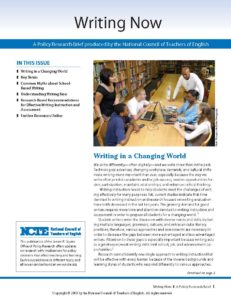Writing Now: A Policy Research Brief by the National Council of Teachers of English
In a world with changing demands and increasingly diverse classrooms, what does good writing instruction look like? NCTE argues that good writing must be holistic, authentic, and varied, and offers research-based recommendations for instruction and assessment with a large list of endnotes for further reading.
Excerpt
Writing, especially at the present moment, is complex and difficult to define. It is used for multiple purposes and is addressed to many different audiences. Yet we do know some important things about writing: it is not created by a singular, linear process; it cannot be taught, like bike riding, as a single skill; it changes with shifting technologies—like today’s new media; it can enable and enhance learning; it takes many forms; and it cannot be assessed effectively in a single sitting. All this means that writing can be seen as holistic, authentic, and varied. Approaching writing as holistic acknowledges the nature of writing development, treats writing as an ongoing process, and considers aspects of writing (such as grammar and punctuation) as parts of a whole. Approaching writing as authentic means seeing it in real-world terms, creating assignments that connect with students’ lived experiences, providing adequate time for writing projects, and evaluating it with multiple measures that consider audience and purpose. Approaching writing as varied means fostering heterogeneous writing skills—such as collaborative and technology-based writing activities—in various genres and disciplines.
Original Source: National Council of Teachers of English, https://ncte.org/statement/writing-now-a-policy-research-brief/


